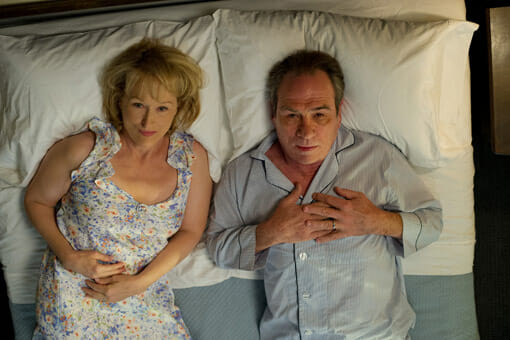By Sunny Choi · August 12, 2012

In all honesty, Hope Springs may not exactly appeal to the mainstream public. This movie will most likely appeal to older generations, particularly those who enjoy getting detailed insight into the lives of everyday, ordinary people. During July and August, many of us often overlook these understated gems in favor of spectacular blockbuster films featuring super heroes and secret agents. Hope Springs stands its ground, as it presents a relatively simple yet fully developed narrative with sympathetic, three-dimensional characters. Unlike its romantic drama contemporaries, Hope Springs leaves behind unnecessary fluff and delves into a plausible conflict between husband and wife.
Kay (Meryl Streep) and Arnold (Tommy Lee Jones) have been comfortably married for thirty-one years. Every morning, she cooks him bacon and eggs. He acknowledges her hard efforts with nothing more than a quick peck on the cheek and occasionally a grunt or one word of approval. Somehow, they have lost the spark in their relationship. Kay misses this intimacy and closeness that they once shared. Everyone, including her co-worker/best friend, tells her that it’s impossible to change a marriage unless one person risks absolutely everything. Desperate for some answers, she consults a self-help book written by Dr. Bernard Feld (Steve Carell), a kind and patient marriage therapist based in Hope Springs, Maine. After much thought and consideration, she decides to book a spot for intensive couples training with Dr. Feld to break this barrier that has formed between her and her husband.
I was surprised at how serious and realistic this movie actually was. Since the trailer had been so fluffy and light-hearted, I was not expecting very much from this movie. However, the movie actually delves into these characters’ fragile emotional state and flaws. The genuine performances from Streep and Jones counteracted the risk of this movie coming off as wooden or forced. Some people might be underwhelmed by this movie because it does not rely on extreme explanations for the slow decline of passion in their marriage (For example, the couple is not recovering from any instances of infidelity or miscarriages). Instead it showcases how multiple factors put strains on their relationship, this film stakes a claim for realism and attempts to be more relatable to couples, especially those that have been married for more than ten years.
The superb acting made this slow-paced film rather captivating and interesting. Arnold’s transformation was especially interesting. While he was also pretty well written, Jones brought out vulnerability and sensitivity in this silent and gruff patriarch, who struggles to accept that he has failed to provide his wife with emotional support. Although we sympathize more with Kay, he undergoes the most amount of emotional growth. As always, Streep undergoes a seamless transformation into her newest character, a reserved and soft-spoken homemaker who genuinely wants to reconnect with her husband. I half-expected Dr. Feld to be a little goofy and unconventional, but Carell adroitly portrays a nurturing therapist who provides his patients with support and guidance. Carell’s subdued performance allows the audience to entirely focus on the plight of Kay and Arnold.
Through humor, this movie also implicitly criticizes those who judge the success of a marriage by evaluating the couple’s material possessions. It’s hard work staying on top of mortgage payments and holding onto your job, maintaining true compassion and intimacy on top of that can be quite a trick, but a marriage cannot run solely on tangible perks alone. Kay and Arnold must learn how to communicate their innermost grievances and make an effort to reconcile their differences. Having a fixed mindset precludes all possibility for change. Their silence represents how they almost give up on each other, labeling the other spouse as unchangeable and incorrigible.
Humorous lines and scenes appropriately complement the film’s dramatic confrontations and discussions. Frustrated with her husband’s fixation with golf, Kay grumbles that she feels like she has married ESPN. After arguing with his wife about traveling to Maine for the therapy session, Arnold takes his colleague’s advice and presents Kay with cheap seashell earrings as a call for amends. While most romantic comedies only follow characters up to their engagement or marriage, this dramedy explores the problems that ordinary couples may encounter after thirty-plus years of marriage and how they could try to resolve their issues.
I sincerely hope that future romantic films will be as developed and focused as this one. These days, many romantic dramedies (Yes I’m talking to you, What to Expect When You’re Expecting) cast multiple famous actors and actresses and try to engage the audience with numerous convoluted plotlines. The only people we see repeatedly are Kay, Arnold, and Dr. Feld. Like in a play or a good TV series, the film’s minimalist setting and detailed dialogue privilege character development over melodrama and suspense. Rather than relying on slapstick comedy or secondary and tertiary characters to complicate the story, the film narrates the struggles of maintaining a fair, balanced, and satisfying marriage. At times, the film feels a little slow and painful, especially when we see the couple floundering to complete exercises or experiencing setbacks. But the performances are such that audiences will empathize enough with the couple and thus come to understand that there is no simple formula for marriage. So if you’re sick of summer bombast, and yearning for human connection, catch this nuanced film.